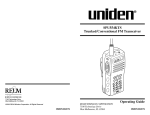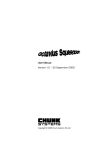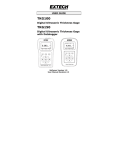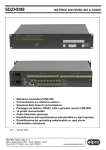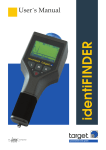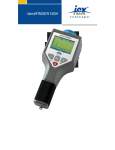Download Uniden SMU250KTS User`s guide
Transcript
SMU250KTS User’s Guide W I R E L E S S C O R P O R AT I O N 7100 Technology Drive West Melbourne, FL 32904 ©2000 RELM Wireless Corporation. All Rights Reserved ULZZ01102ZZ RELM WIRELESS CORPORATION 7100 Technology Drive West Melbourne, FL 32904 OMSMU250KTS Safety information Two year Limited Warranty Through the provisions of the Occupational Safety and Health Act (OSHA) of 1970, the United Status Department of Labor has established an electromagnetic safety standard which applies to the use of two-way radio equipment. The proper use of this transceiver will result in exposure below the OSHA limit. The following precautions shall be observed: WARRANTOR: RELM Wireless Corporation (“RELM” or “Warrantor”). • DO NOT operate the transceiver of any radio equipment with the antenna touching, or close to, the eyes, faces, or exposed body parts. • DO NOT operate the transmitter of any radio equipment unless all the Radio Frequency (RF) connectors are secure and any open connectors are properly terminated. • DO NOT operate the transmitter of any radio equipment near electrical blasting caps or in an explosive environment. • DO NOT let children operate any transmitter-equipped radio equipment. • Have your radio equipment installed and service by a qualified technician. Caution: RELM does not represent this radio to be waterproof. Do not use the radio in damp or high-moisture environments. ELEMENTS OF WARRANTY: RELM Wireless Corporation warrants to the purchaser that all new Radio equipment of RELM's manufacture shall be free of defects in material and workmanship. Equipment and accessory items not manufactured by RELM carry the standard warranty of the manufacturer thereof. WARRANTY DURATION: The warranty period for all parts is two (2) years. The warranty period shall commence upon installation of the equipment or two (2) months from the date of shipment from the factory, whichever comes first. The warranty shall terminate and be of no further effect two (2) years from its origin or at the time the Product is (a) damaged or not maintained as reasonable, (b) modified, (c) improperly installed, (d) is repaired by someone other than Warrantor or Authorized Warranty Repair Station for a defect or malfunction covered by this Warranty, or (e) used in a manner or purpose for which the Product was not intended or in an environmental condition for which the Product was not intended. STATEMENT OF REMEDY: Where permitted by law, this Warranty is in lieu of all other Warranties expressed or implied, including warranties of merchantability or fitness for a particular purpose, and no representative or person is authorized to assume for us any other liability. This warranty shall not extend to incidental or consequential damages arising from operation of Product(s) which are subject of this Warranty. Some States do not allow limitation of implied warranties so the above limitations may not be applicable. You may have rights as defined by individual State law. WARRANTY REGISTRATION CARD: In order to facilitate the service under this Warranty, Purchaser should return the Warranty Registration Card to Warrantor. However, return of the Warranty Registration Card is not a precondition of this Warranty. This Warranty will be observed by the Warrantor whether or not the Warranty Registration Card is returned, on the condition that other evidence, satisfactory to Uniden, of the date of the original installation or purchase is provided to the Warrantor. PROCEDURE FOR OBTAINING PERFORMANCE OF WARRANTY: To obtain warranty service, the Customer must return the radio properly packed, freight prepaid, to Warrantor or any Authorized Warrantor Repair Station. It will be returned freight prepaid. ©2000 RELM Wireless Corporation All Rights Reserved 2 23 Contents Operational Check After installation, a complete operational check by your Uniden Dealer will assure you of a quality installation. Accessories Safety Information ................................................................................ 2 Heavy Duty Microphone ...................................................... AMX105A Introduction .......................................................................................... 5 Congratulations ............................................................................... 5 Description ..................................................................................... 5 Service ............................................................................................ 5 Features ........................................................................................... 6 Programmable Features .................................................................. 6 Mobile Power Cord w/Fuse (15A) ....................................... AMX120A Unpacking ............................................................................................. 7 Base Station Microphone......................................................... AMX151 Controls and Functions ......................................................................... 8 External Speaker (4 ohm, 10 Watt) .......................................... AMX250 General Operation................................................................................. 9 LCD Display ................................................................................... 9 Applying Power and Setting the Volume ........................................ 9 Standard Microphone ........................................................... AMX100A DTMF Encode Microphone................................................. AMX101A 110VAC Power Supply (with built-in speaker) ................... ST14P1001 220VAC Power Supply (with built-in speaker) ................... ST14P1002 Technical Support and Service Your Uniden dealer can provide you with technical assistance and information. If your radio does not perform properly, take it to a Uniden dealer for servicing. The radio contains no user-serviceable parts. Unauthorized adjustment will void the warranty and may cause illegal radio operation. Be sure that a qualified technician services your radio equipment. When servicing the radio, use only factoryauthorized replacement parts. Trunking Mode Operation .................................................................. 10 Talk Group Selection .................................................................... 10 System Selection .......................................................................... 10 Transmit ........................................................................................ 10 Telephone Operation..................................................................... 11 Receive ......................................................................................... 11 Scan Operation ............................................................................. 11 Scan Limitations ........................................................................... 12 Scan Lock Out .............................................................................. 13 Revert Operation........................................................................... 13 Queuing and Tones ....................................................................... 14 TAC Operation ............................................................................. 14 Call Function ................................................................................ 15 Call Alert Function ....................................................................... 15 Telephone Interconnect Functions ................................................ 16 Other Functions .................................................................................. 17 MENU Operation ......................................................................... 17 A/B/C Quick Keys Operation ....................................................... 18 Conventional Operation ...................................................................... 19 Transmit/Receive .......................................................................... 19 Transmit Time Out Timer (TOT) .................................................. 19 22 3 Busy Channel Lockout ([SOLO) .................................................. 19 Scan .............................................................................................. 19 Special Features .................................................................................. 20 Function Tones.............................................................................. 20 Radio Installation ................................................................................ 21 Considerations .............................................................................. 21 Power Requirements .................................................................... 21 Antenna ......................................................................................... 21 Mounting ..................................................................................... 21 Operational Check ....................................................................... 22 Accessories ................................................................................... 22 Technical Support and Service ..................................................... 22 Two-year Limited Warranty................................................................ 23 Radio Installation Considerations All Uniden radios and associated accessories are tested before shipment to ensure operational status. However, since vehicle configuration in which Uniden radios and accessories are installed are non-standard, Uniden recommends the following installations considerations . Power Requirements The SMUP250KTS requires a 13.6V DC, 10 ampere power source with a negative ground. Install a fuse in the power leads near the power source to protect the power source compartment and passenger compartment from fire and electrical hazards. (The AMX 120A Power Cable is equipped with an in-line 15 ampere fuse.) If the radio is connected directly to the vehicle battery, a fuse must be installed as close to the battery terminal as possible. Route power leads to minimize proximity to other electrical systems such as instruments, engine electrical components, braking systems, entertainment systems, etc. Secure power leads to supporting structures or components with insulated clamps that completely isolate the power leads from the supporting structures or components. When power leads are routed through a firewall, bulkhead, or similar structure, use a rubber grommet to protect power leads from chafing. Antenna Follow antenna manufacturer's mounting instructions. Mount antenna in a location which gives the highest unrestricted radiation pattern. Use low loss, 95% shielded, Teflon coaxial cable between antenna and radio antenna jack. Keep antenna cable length short to insure maximum power output. Mounting Mount the equipment with your safety and the safety of others in mind. Do not obstruct the operator's physical or visual access to the controls. Ensure easy access to the microphone and radio controls. Be sure the equipment does not interfere with the vehicle's operation. 4 21 Special Features Introduction Function Tones Congratulations The radio is equipped with several tones to indicate error conditions or confirm functions have occurred. You now own the best value in trunking radio systems, a Uniden professional communications radio. The SMU250KTS is an integral part of a trunking radio system which consists of many radio channels with high powered repeater stations that extend range and provide greater access to available channels. Power On Tone - a high pitch tone indicating the radio has powered up normally. Malfunction Tone - a long low tone at power on indicating a radio problem. If it persists, return the radio to your Uniden dealer for repair. Function Enable Tone - a short high tone indicating the key function has been turned on. Function Disable Tone - two short low tones indicating that the key function has been turned off. No Function Tone - a low/high/low/high tone sequence indicating the key function is not allowed. Your SMU250KTS Two-Way FM Transceiver offers many special features and can be programmed by your Uniden dealer to provide the features that best meet your needs. Read this Operating Guide completely to be sure you are getting the most value and performance from your new radio. Description Down-Select Tone - a short low tone occurring at every down-select change. The SMU250KTS is a trunked/conventional mobile Two-Way FM Transceiver. It is microprocessor-controlled, frequency-synthesized, and programmable. It is rugged and designed for easy installation in small spaces. PTT Error Tone - a low tone sounding as long as the PTT is held, if transmit is not allowed on the selected channel. The SMU250KTS operates in the 450 to 494 MHz range with a maximum RF power output rating of 25 watts. BCLO Tone - alternating high/low tones sounding as long as PTT is held if the channel is busy. Service TOT Caution Tone - short high pitch beeps sounding every second, beginning 5 seconds before transmitter shutoff occurs. TOT Error Tone - a high pitch tone sounding as long as the PTT is held, after TOT has occurred. Priority Tone - a short high pitch double beep sounding during scan when the Priority Channel is received. If your radio does not work properly, take it to a Uniden dealer for servicing. These radios contain no user serviceable parts. Unauthorized adjustments will void the warranty and may cause illegal radio operation. Make sure that a qualified technician services your radio equipment. When servicing these radios, use only factory authorized replacement parts. Connect Tone - a Function Enable Tone sounding when system access is achieved. System Busy Tone - recurring beeps of the DTMF 7 tone pair occurring when access is attempted on a busy system. Intercept (Out of Range) Tone - Continuous DTMF 7 tone pair occurring after 4 unsuccessful handshake attempts. 20 5 Conventional Operation Features • Up to 50 systems • Up to 100 trunked talk groups or conventional channels • Carrier squelch and multiple CTCSS/DCS operation • 10 character Talk group/Channel/Function LCD • System and group scanning • Busy system queueing • Connect tone alert • Talk-Around-Channel (TAC) operation • User-Configurable Channel Scan List • Ten number pre-programmed Phone Book Conventional (non-trunked) channels, if programmed, may be selected in the same manner as described for trunked talk groups. Operation features relative to conventional operation are described below. Transmit/Receive 1. Select the desired channel with the Up- or Down-select keys or A/ B/C Quick Keys. 2. Press the M/EXIT key to monitor the channel for activity. The LCD will display MONI ON for 2 seconds. If the channel is busy, wait until it is clear. 3. Press the PTT key to transmit. The TX display will illuminate. For best voice quality when transmitting, hold the microphone vertically about one inch from your mouth. 4. Release the PTT to receive a reply. Programmable Features Transmit Time Out Timer (TOT) The operating frequencies and options have been pre-programmed into your radio by your Uniden Dealer. Check with your Dealer for the specific features in your radio. • Scan Type Continuous transmission time may be limited by programming selection. Five seconds before the time-out, caution beeps will sound every second. After five seconds, transmission will stop and an error tone will sound as long as the PTT is held. When the PTT is released, the TOT is reset. • Revert Type Busy Channel Lockout (BCLO) • Scan Dropout Delay • Transmit Dwell Time The radio may be programmed to inhibit transmission while a signal is being received. If so, an error tone will sound if PTT is pressed while the channel is busy. • Transmitter Time Out Timer Scan • Busy Channel Lockout • Function Tone • TX Power High Low • A/B/C Quick Key Functions Scan may be activated by a programmed A/B/C Quick Key or MENU operation. All channels not locked out will be scanned. Individual channels may be locked out of scan by pressing the L/O button on the desired channel. If scan priority is programmed, receipt of a signal on the first channel in the selected system will cause the Priority Tone to sound. Transmit will always occur on the selected channel during scan operation. 6 19 A/B/C Quick Keys Operation Unpacking The A, B and C Quick Keys can be programmed for any of 10 functions as described below. The following should be included with your two-way radio: • • Talk Group/Channel Recall - Either or both keys may be programmed with selected talk groups or conventional channels. TAC - Talkaround operation for the selected talk group or conventional channel may be activated by programming either key. • Scan - Talk group scan or system scan may be activated from either key. • Phone Book - The Phone Book function may be activated to allow recall of programmed numbers. • Key Lock - All keys except PTT and EXIT may be locked. • Manual Revert - During scan, the last received talk group may be selected as the active talk group, even if scan has resumed. This allows you to quickly respond to a call even if Last Call Revert or Talkback Revert Scan types are not programmed. • Power - High or low transmit power may be selected. Talk groups programmed for low power cannot be changed to high power. • Option - Internal or external options can be turned on/off. • Backlight - Backlight level of keys and display can be selected. • DTMF Redial - While programmed for any function above except Scan, either key may also be programmed for the secondary function of DTMF Redial as described under DTMF Keypad Functions. • Up/Down System Select - allows selection of the next higher or lower system (automatically displays the first talk group in that system). 18 • Transceiver Unit • Power Cord • Mounting Bracket • Operating Guide (OM) If any of these items are missing from the box, contact your Uniden Dealer for help. FCC Licensing Before you transmit with your radio, you must have the proper license issued by the Federal Communications Commission (FCC). Your Uniden Dealer can tell you what is required, and can help you with all your future communication needs. Features, specifications, and availability of optional accessories are all subject to change without notice. 7 Controls and Functions Other Functions MENU Operation The MENU key allows accessing menus of up to 8 different functions, if programmed. They are Phone Book, Scan, TAC, Power, K Tone, K Lock Opt and Backlight. Repeatedly pressing the MENU button will sequentially display each of these menu items. When the menu item of interest is displayed, the Up- and Down-select keys can be pressed to make choices within the menu. Menu operation will automatically be exited when the MENU key is pressed to accept the displayed choice, or the M/EXIT button may be pressed to accept the current choices and return to the selected talk group. The choices within each menu are briefly described below. Microphone Jack - Allows attachment of standard, DTMF or base station microphone. • On/Off/Volume Control - Allows the radio to be powered off and on and the volume to be adjusted. PHONE BOOK - any of 10 pre-programmed numbers may be accessed. • SCAN - Off, Talk Group Scan or System Scan may be selected. Up/Down Select Key - Allows selection of talk-groups, conventional channels and Menu selections. • TAC - TAC on or off may be selected. • M/Exit - Allows channel monitoring in conventional mode. In trunking mode it activates the volume setting tone and exits the Menu mode. POWER - High or low transmit power may be selected. Talk groups programmed for low power cannot be changed to high power. • K TONE - Key tone on or off may be selected. When off, all tones related to key functions are disabled. L/O - Allows talk-groups or channels to be added to or removed from the scan list. • K LOCK - Key lock on or off may be selected. When off, all keys except PTT and MENU are locked. A/B/C - Option keys programmable for any of ten functions. • OPT - Horn Alert, scrambler or other option may be selected. • BKLIGHT - High or low backlighting of the display and keys may be selected. Menu Key - Allows selection of any of eight optional functions. 8 17 Telephone Interconnect Functions Phone Book - Any of 10 pre-stored memory numbers can be recalled by the A/B/C quick keys or the MENU operation. Press the A/B/C key to display the first number, then press again as many times as necessary to recall the desired number. Alternatively, the Phone Book function may be accessed by pressing the Menu key. When PHONE BOOK is displayed, press the UP/DOWN keys to scroll through the programmed numbers until the desired one is displayed. Press PTT to access dial tone on an interconnect repeater, then press PTT again to transmit the number. Numbers with more than 10 digits will automatically scroll to display the last 10 characters. DTMF Redial - The A/B/C quick keys may be programmed to recall the previously displayed Phone Book number for redial. To use this function, access dial tone on an interconnect repeater as described above, then press the A, B or C key and hold for 2 seconds. The last transmitted Phone Book number will be displayed and can be transmitted by pressing PTT. General Operation LCD Display The liquid crystal display (LCD) has 10 characters to designate the selected group or channel by number or name. Above the channel designation area is a row of indicators that show which features are enabled. TX The unit is transmitting L/O Channel removed from Scan List OPT An external option has been activated TAC Repeater talkaround is enabled SC Scanning is in operation TEL An interconnect talk-group has been selected BUSY Unit is in queue MSG Indicates a call has been received Applying Power and Setting the Volume 1. Turn the radio on by turning the POWER/VOLUME knob clockwise. The display lights and shows the last-selected talk group/channel designation. Note: To turn the radio off, turn the POWER/VOLUME knob counterclockwise to the off position. 2. Adjust the speaker volume to a comfortable level by turning the POWER/VOLUME knob. Press the M/EXIT button to produce a volume setting tone. Press the M/EXIT button again to turn the tone off. 16 9 Trunking Mode Operation Talk Group Selection 1. Up/Down Select- Press the Up/Down key ( A or v ) to display the desired talk group. An up-select or down-select tone sounds with each change. If you press and hold either key, the radio changes talk groups rapidly. (If programmed with a "stop", talk group changes will stop when the highest or lowest talk group number has been reached.) 2. A/B/C Key Selection - Either or all three of the A, B and C keys may be programmed for instant selection of a pre-programmed talk group. Press the programmed key to instantly select the programmed talk group. System Selection The A/B/C keys may also be programmed as System Select keys, Up or Down. If so, pressing the key will select the first talk group on the next higher or lower system. The desired talk group in the new system can then be selected using the Up/Down Select key as described above. (Check with your service provider to confirm exact key programming.) Transmit 1. Select the desired talk group as indicated above. 2. Press the microphone PTT key. Keep the PTT button depressed while you transmit your message. Notice that the TX indicator flashes at least twice while the radio "handshakes" with the repeater system. Delay speaking until the TX indication is steady. If the Connect Tone is programmed, just wait for it to sound, then TAC mode may be accessed from the MENU operation. In either case, the current TAC mode is indicated in the LCD display as TAC OFF or TAC ON during the selection process and can be cycled to the opposite mode by pressing the Up- or Down-select key (if accessed by the MENU key) or the A/B/C key. When active, TAC mode is continuously indicated by the LCD TAC icon. Call Function Each talk group may be programmed to flash the MSG icon if a call is received when that group is selected. Also, up to two talk groups may be programmed to display the MSG icon continuously if they are called while selected or while scanned. The MSG icon is turned off by pressing any key. Call Alert Function The unit may be programmed to sound an alert associated with the Call function described above. An alert tone sequence will sound from the radio speaker and also from the horn (if the Horn Alert option is installed). To activate the Call Alert feature: 1. Press the A/B/C key programmed for that function. OPT ON will appear on the main LCD display for 2 seconds, then be replaced by the selected talk-group. The OPT indicator above the LCD will illuminate. Or, press the MENU key until the OPT OFF display appears. Press the UP/DOWN key to change the display to OPT ON, then press the MENU key to exit the menu function. 2. When a call is received on the selected group, a thirty second sequence of three beeps will sound from the speaker and the horn (if connected). After the thirty second period, the tone sequence will stop, but the MSG icon will continue to be displayed until it is turned off. 3. To disable the alert tones and turn off the OPT function, press the microphone PTT or any front panel key. 10 15 Queuing and Tones • Busy System Queuing - when programmed for queuing and the system is busy when you try to transmit, the radio will automatically enter the queueing mode, indicated by the BUSY indicator and a high-pitched triple beep. When queued, the radio will monitor the busy system and try every 5 seconds to capture a channel when it becomes available, indicated by a high-pitched double beep sounding every 10 seconds. If the 60 second queuing period elapses without successful system access, a I second low tone sounds and the queuing mode is discontinued. If a channel does become available during the queuing period, it is held for 10 seconds, indicated by a single high tone sounding every second. Pressing PTT during the 10 second period will initiate normal operation on the selected talk group. If the PTT is not pressed during this period, the channel is released and the queuing mode is exited. begin talking. If transmission is difficult, try to find a higher location with fewer obstructions between you and the repeater site. Release the PTT key when your message is finished. 3. For best voice quality when transmitting, hold the microphone about one inch from your mouth. Telephone Operation 1. Select a talk group allowing telephone access, indicated by the TEL symbol at the top of the display. 2. Press the PTT to access the system, then release to gain dial tone. 3. Transmit the number manually entered (requires a DTMF microphone) or recalled as described under Phone Book. 4. If someone answers, key the transmitter to talk and release to listen. • Busy Tone - if the repeater is in range but busy, you will hear a series of busy tones similar to a telephone busy signal. Release the PTT and try again in a few minutes. 5. When transmission is complete, "hang up" the connection by pressing the # button on the keypad or the M/EXIT button, or by placing the microphone in its holder. • Intercept (Out of Range) Tone - If the radio fails to "handshake" with the repeater after 4 attempts, the intercept tone sounds continuously until PTT is released. Receive • Connect Tone - when programmed for connect tone operation and the radio has successfully accessed the system, a single quick beep alerts you to begin talking. TAC Operation To allow direct radio-radio communications in circumstances where both units may not be able to access the repeater, the Talk Around Channel (TAC) mode may be activated. Talk Around channels may be pre-programmed and selected as any other talk group, indicated by the TAC LCD indicator. Also, one of the A/B/C quick keys may be programmed for that purpose or the 14 Select the talk group you want to receive as indicated above. Scan operation may be activated as described below to automatically monitor a number of talk groups. Scan Operation In the scan mode, the radio monitors each talk group in the selected system or all systems until it receives a call. You can scan all talk groups/systems, or you can lock out individual talk groups/systems from being scanned. 1. Scan operation may be activated through the MENU operation or one of the A/B/C keys may be programmed for that purpose. 11 • • MENU Scan Activation - press and release the MENU key to display the current scan condition. Press the Up- or Downselect keys to select the desired condition (SCAN OFF, SCAN GRP or SCAN SYS). The LCD SC indicator will be displayed continuously when talk group scan is active and blink when system scan is selected. Exit menu operation by pressing the MENU or MON/EXIT keys. A/B/C Key Scan Activation - press and release the A, B or C key to activate scan of all talk groups in the selected system. The LCD SC indicator will be displayed to indicate talk group scan. Press and hold the key for 2 seconds to activate scan of all systems, indicated by the flashing SC icon. To deactivate either talk group or system scan operation, press and release the A, B or C key. 2. If scan priority is programmed, receipt of the priority talk group (first talk group in the selected system) will be accompanied by sounding of the Priority Tone. After the first group, the order of priority is group 2, the selected group, then the balance of the groups in the selected system in the programmed order. Scan Lock Out Individual talk groups or complete systems can be locked out of the scan list at any time. • Talk Group Lock Out - press and release the L/O key to lock out the currently selected talk group. The L/O icon will be displayed to indicate the lockout condition. Press and release the L/O key again to restore the selected talk group to the scan list. • System Lock Out - press and hold the L/O key for 2 seconds on any talk group in the system. The L/O icon will blink when any talk group in that system is selected, regardless of whether that group has been individually locked out. Press and release the L/O key on any talk group in a locked out system to restore the system to the scan list. Revert Operation During scan operation, the active talk group selection may change depending on the revert programming. • Last Talk Group Revert - the received talk group becomes the active talk group. • Talkback Revert - the received talk group becomes the active talk group only if the PTT is pressed during the dropout delay time (period before scan resumes). • No Revert - Operation will take place on the received talkgroup as long as the PTT is pressed within the dropout delay time, but will return to the selected talk-group when the DOD time is allowed to expire. Scan Limitations • • System Scan - If System Scan is activated from an LTR talkgroup, all trunking systems (but no conventional systems) will be scanned. If TAC operation has been activated from the Menu or A/B key, only the TAC repeater and TAC ID of each trunking system will be scanned. If a pre-programmed TAC talk-group was selected when scan was started, that TAC repeater and the home repeaters of all trunking systems will be scanned. Similarly, activating System Scan from a conventional talk-group will cause only conventional systems to be scanned. Group Scan - All talk-groups in the selected trunking system will be scanned during Group Scan. However, if TAC is in operation, Group Scan in a trunking system cannot be activated. In a conventional system, Croup Scan will scan all programmed channels. 12 13













